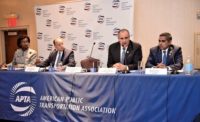Like their bridge and highway counterparts, U.S. mass-transit builders are catching the public-private partnership bug. But some issues pose challenges, such as the environmental permitting process and the uncertainty of long-term federal funding.
"State-of-good-repair projects are good candidates for P3s, but the private sector needs clarity of timeframes," said Karen Hedlund, the Federal Railroad Administration deputy administrator. Speaking to attendees of the American Public Transportation Association, she noted that transit agencies might offer stipends for unsolicited proposals to "telegraph serious intent" about pursuing P3s.
Unlike highway projects, on which concessionaires can reap toll revenue, transit projects would depend on availability payments, said David Narefsky, a Mayer Brown LLP partner. He cited examples in Canada, such as Vancouver's $1.7-billion Canada Line, for which SNC-Lavalin leads a 35-year concessionaire contract. Availability payments are based on availability of trains, quality of service and the team's ability to attract more ridership, he noted. The government still sets the fares and collects the revenue. A current $1.4-billion P3 in Ottawa features a new light-rail system and an adjacent highway, Narefsky added.
Maryland is proposing a P3 for the planned $2-billion Purple Line project. Denver's six-year, $2-billion Eagle P3 reached the halfway mark this year.
Held in Chicago, the APTA meeting commenced in the shadow of a local commuter-rail collision and the federal shutdown, which sent home early many Federal Transit Administration attendees. But Mayor Rahm Emanuel (D) cheered those present with a detailed description of the $425-million, 10-mile Red Line subway upgrade, completed this month.



Post a comment to this article
Report Abusive Comment